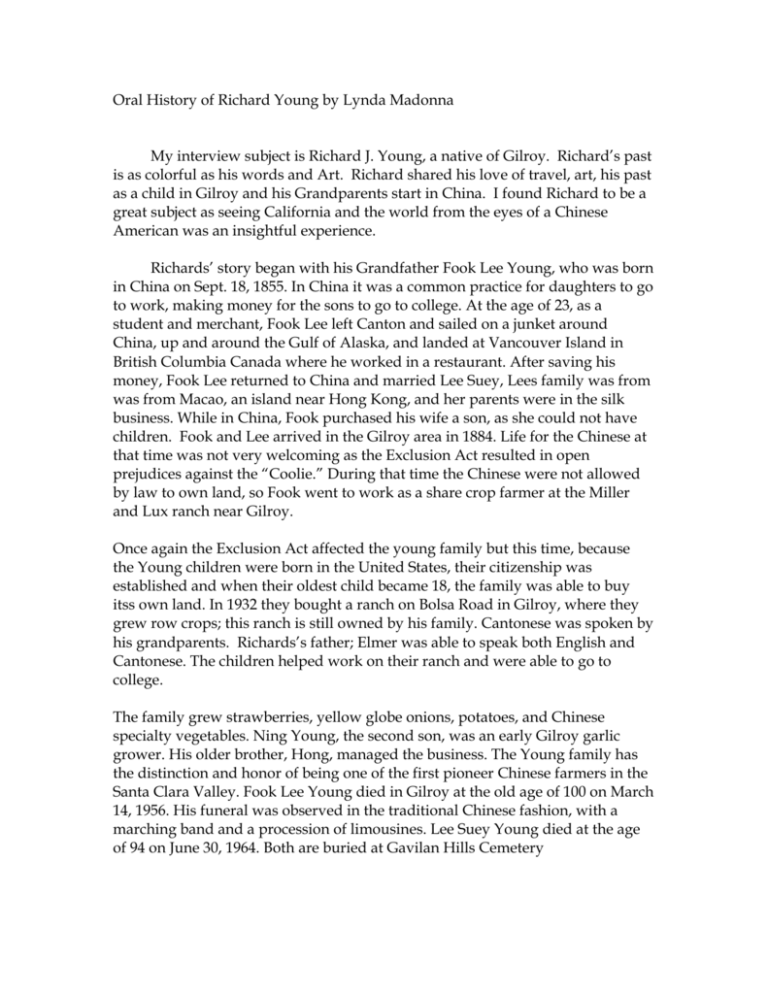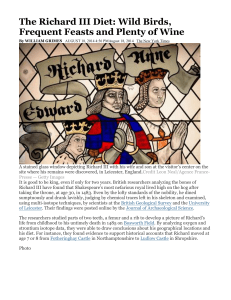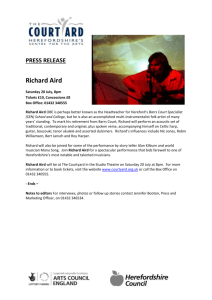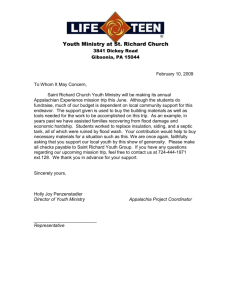Oral History of Richard Young by Lynda Madonna
advertisement

Oral History of Richard Young by Lynda Madonna My interview subject is Richard J. Young, a native of Gilroy. Richard’s past is as colorful as his words and Art. Richard shared his love of travel, art, his past as a child in Gilroy and his Grandparents start in China. I found Richard to be a great subject as seeing California and the world from the eyes of a Chinese American was an insightful experience. Richards’ story began with his Grandfather Fook Lee Young, who was born in China on Sept. 18, 1855. In China it was a common practice for daughters to go to work, making money for the sons to go to college. At the age of 23, as a student and merchant, Fook Lee left Canton and sailed on a junket around China, up and around the Gulf of Alaska, and landed at Vancouver Island in British Columbia Canada where he worked in a restaurant. After saving his money, Fook Lee returned to China and married Lee Suey, Lees family was from was from Macao, an island near Hong Kong, and her parents were in the silk business. While in China, Fook purchased his wife a son, as she could not have children. Fook and Lee arrived in the Gilroy area in 1884. Life for the Chinese at that time was not very welcoming as the Exclusion Act resulted in open prejudices against the “Coolie.” During that time the Chinese were not allowed by law to own land, so Fook went to work as a share crop farmer at the Miller and Lux ranch near Gilroy. Once again the Exclusion Act affected the young family but this time, because the Young children were born in the United States, their citizenship was established and when their oldest child became 18, the family was able to buy itss own land. In 1932 they bought a ranch on Bolsa Road in Gilroy, where they grew row crops; this ranch is still owned by his family. Cantonese was spoken by his grandparents. Richards’s father; Elmer was able to speak both English and Cantonese. The children helped work on their ranch and were able to go to college. The family grew strawberries, yellow globe onions, potatoes, and Chinese specialty vegetables. Ning Young, the second son, was an early Gilroy garlic grower. His older brother, Hong, managed the business. The Young family has the distinction and honor of being one of the first pioneer Chinese farmers in the Santa Clara Valley. Fook Lee Young died in Gilroy at the old age of 100 on March 14, 1956. His funeral was observed in the traditional Chinese fashion, with a marching band and a procession of limousines. Lee Suey Young died at the age of 94 on June 30, 1964. Both are buried at Gavilan Hills Cemetery Richards’s father Elmer had a great love for art. This was first guided by his high school art teacher, and then he went off to college. Elmer’s’ first art studio was in the basement of the old Strand Theater in downtown Gilroy. From there Elmer started his sign business, “Young Signs,” at a building near Church and 5th Street. In 1945 Elmer bought the building at 7393 Eigleberry where his business still remains and is run by his son Richard. Richards mothers was from Sacramento and was a stay-at-home Mom. Richard was born in Gilroy in 1942.He is the oldest of three children, and both his brother and sister were also born in Gilroy. Today Richards’s brother is a dentist in Los Altos; his sister lives in Lake Tahoe. Richard’s family life in Gilroy was filled with family gatherings at the ranch, church, education and sports. In his youth, Gilroy life was filled with the Gymkhana Rodeo, open fields, agriculture and cattle. Gilroy, like a lot of towns in California, had its’ own Chinatown that had gambling houses and brothels. These businesses were used not only by the locals, but a bus would bring neighboring town workers in by bus, to enjoy themselves for an evening or two. Gilroy has grown into a sleepy bedroom, agricultural small town with old families that have strong cultural connections to the land and family. During WWII Gilroy was blessed with agricultural jobs, but travel was minimal as gas stamps limited travel even into neighboring San Jose. Many Asian persons lost property or were sent to relocation Camps (if they were Japanese), but for the Young family in Gilroy life carried on. While in high school Richard enjoyed his art. He played football, baseball and ran track. As a Chinese child found that he was not allowed to swim in the city public pools. This was another piece of life that a Chinese American had to overcome. Richard shared with me that before graduating from high school, he had to swim the length of the school pool, so he taught himself to swim and was able to graduate with his class. After high school, Richard went to Hartnell College where he receive his teaching degree, then to San Jose State and received a Masters degree in painting and sculpture. While at college, Richard met Carolyn and married in 1958. After college they both returned to Gilroy, where Caroline was a stay-at- home mom. Carolyn was very active in her children’s life and the community; she was a member of the Beta-Sigma Phi organization in Gilroy. Carolyn died in 1985 from ovarian cancer. During the Viet Nam War, Mohammad Ali asked why he should go to war when he didn’t have anything against the Viet Nam people. It did not matter to Ali that he would be stripped of his heavy weight boxing title, his moral standing was in question and for him peace in the world and kindness to all people was more important. Richard said that this was an amazing statement for a minority person in that day--to speak out was rare. Richard and Carolyn had three daughters; Natalie, Ashley, and Lisa. The Gilroy School District had a Young family member attending Gilroy Schools from 1900 until Natalia graduated from High School in 1986. Richard shared that the Gilroy public education system is a slice of life, as it shows their students what one has to deal with in life. Ashley works at a college, Natalie is a lawyer in Mission Bay and Lisa Pistachio works at the Assistant DA’s office. Richard married a second time to Kim Phoffschildt in 1992; Kim is an artist and a runner. Kim and Richard bought a home in Mazatlan, Mexico, where Kim lives as they divorced after ten years but remain friends today. Richard followed in his father’s footsteps with his artistic ability; he even had the same high school art teacher. Richard originally began his career as a painter and sculptor but needing to support his family, so he taught painting, sculpture and computer graphics, at Gavilan College in Gilroy. He taught art in Stockton . also. He taught from 1970 to1994. While at Gavilan Richard started the Life Drawing program. He was also on the Gilroy Unified School District school board. Richards’s passion for art has inspired him to travel around the world. While travelling in Spain he studied Salvador Dali’s work, went to Monasteries and to Avilla the wall city. He travelled to the Louver in Paris, Rome, and Florence and to Santorin in the Greek Islands. In the late 1970s, Richard had several pieces of his work shown at one of the first Ethnic Studies Art shows at the San Francisco Museum of Art. Richard shared that in travelling the world he has seen how so much of the World is like a third world country where only 2-5% enjoy the big city privileges. The poor outweigh the privileged and wealthy. He has seen how only a few hold all the money and wealth of the world, which is not shared, making the world a sad place. He saw poverty on farms where people starve. He states that people in the United States don’t realize how blessed they are, and how wasteful they can be. Richard started the Gilroy Running Club in the early 1970’s. This club started out small with just a few members but grew. The running club had an annual Halloween run where monies were raised donated to different community businesses that helped out those in need. Richard and the running club also had an annual Garlic Run that took place on opening day of the Garlic Festival. Local businesses participated in offering shoes and gift certificates for running shoes and other merchandise at their stores. People of all ages joined in the run with hopes this would be a future the young runners would see as a fun future and family activity. This run was called the Garlic Run, and the club then was known as the Stinking Rose run. The Gilroy running club ended in 2004, and then the South Valley running club took over with community events. Richard still runs daily, and has traveled to run races in New Zealand, the Philippines, and Hawaii. Richard is a deeply thoughtful open man. He shared that the Chinese family is a close, private group. Education is the building block of their culture. The goal in life is work hard and to aspire to be the best you can be and never embarrass the family. If within the Chinese family a problem arises, then in unity support is given and answers are found with guidance. A lesson is learned to be carried forward so one can move forward to be at their top of their game once more. Richard says he would like for every person to know that they have a purpose and a place in life. Today people have become confused by success and many think things are what make you successful. Everyone needs dreams and aspirations because, that’s what will drive them. Richard says “I want to be a mentor to the young. My advice is RACE TO BE YOUR BEST BUT DON’T MISS THE JOY OF BEING.”








